Well, that’s a strange title, huh? I promise it’s not a typo. I will come back to that shortly. This month’s edition of Forgotten Silver will pick up where I left off last month by filling in the blanks that Dan’s contact provided us regarding Coach House’s strange comic book offerings from the 1960s and 1970s.
Just to reiterate, Dan, Victor and I came together as a research group because of Snore Comix and quickly identified that at least three issues were published. We subsequently learned that Vincent Trasov’s “Mr. Peanut Flipbook” was also likely part of the series. Prior to receiving a sizable packet of information from Dan’s contact (who does not want to be identified), we came across two additional snippets of information that added to the puzzle. I did not discuss either of these leads last month, so that is where I will start today.
The first of these two leads was found in Coach House’s Books in Print – Winter-Spring 1972 catalogue, which lists some of Coach House’s graphic novels that I discussed last month (including Martin Vaughan-James’ The Projector and Joe Rosenblatt’s Greenbaum). The same pages include a listing for issues # 3-7 of Snore Comix, including the “Mr. Peanuts Flip Book” by Mr. Peanuts as Snore Comix # 4 proving that Trasov’s offering was intended to be part of the series. The three subsequent issues are listed as “The Shoe Book” by George Saia, “The Slug Book” by Gerry Gilbert and “The Coach House Nose Who’s Who” by Eduard Lang.
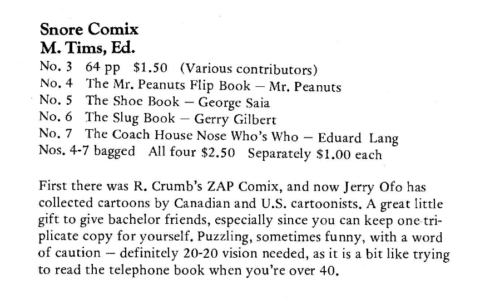
This advertisement in an old Coach House catalogue ended up being a significant lead. We now knew that seven issues of the series had, at least, been planned. We also knew that George Saia was a pseudonym for General Idea’s Jorge Zontal and we were quickly able to learn about the odd history of “The Shoe Book.” Unfortunately, we could not say the same thing for Gerry Gilbert, Eduard Lang, or their apparent standalone issues of the series at the time.
There are several things that make “The Shoe Book” a bizarre part of the Snore Comix trajectory. Rather than being a comic book, it was a series of images and sketches created by Zontal as he attempted to create the ideal graphic motif of the stiletto shoe. The end result of this work is a series of images of slightly different looking stiletto shoes. We know this because, in 2007, Toronto visual artist Robert Fones completed Zontal’s project as an Art Metropole publication. Ultimately, Fones created a hardbound book using the original material that Zontal had created and printed, but never published or distributed as the Shoe Journal. As we learned, Snore Comix # 5 was never actually finished or released by Coach House. However, thanks to Fones, 100 copies of the Shoe Journal were published. Apparently, copies are still available for sale here.
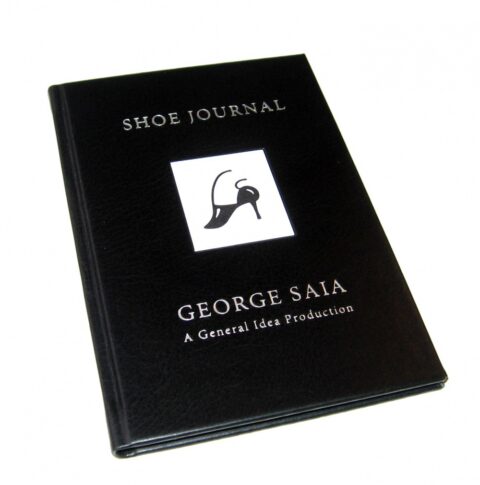
The fact that “The Shoe Book” was never published and (like the “Mr. Peanut Flipbook”) stretches the limit of what can be considered a comic book was disappointing to learn. That said, as I researched General Idea and learned more about their subsequent work and rise to fame in the art world, I came to realize that Zontal’s obsession with the stiletto shoe became a key motif for the group. The image of the stiletto appears again and again in the art of General Idea and the fact that this was originally developed as part of the then George Saia’s attempt at creating the fifth issue of Snore Comix cannot be understated.
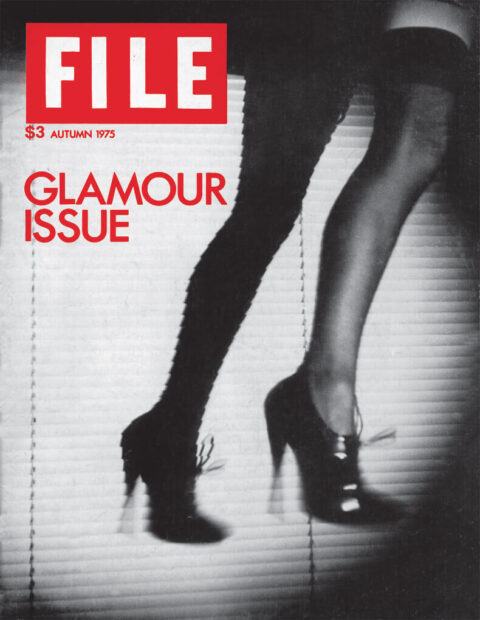
Thanks to Art Metropole and Robert Fones, a significant part of the Snore Comix mystery was revealed to us after we learned about issues 5, 6 and 7 due to the abovementioned Coach House catalogue. However, we found no information about the later issues of the series attributed to Gerry Gilbert and Eduard Lang and the case went cold again. Then, one day after quite a bit of work on Dan’s part, his contact came through and filled in many of the blanks.
According to Dan’s contact, there were nine issues of the series, “but not really.” His contact to him that, “There were 7 but then again (being Coach House) there weren’t. The first 2 were edited by Jerry ofO (the 2nd with input from Victor Coleman & bpNichol). The 3rd was edited by Victor with help from Michael Tims (aka AA Bronson) who’s (sic.) credited alone with editing it in the catalogue.” The contact then explained that issues # 4 and 5 were General Idea conceptions and that Trasov was part of their inner circle at the time. Issue # 6 was a spontaneous creation by Gerry Gilbert for Victor Coleman’s poetry class, while issue # 7 was, “all Jim Lang.” A subsequent issue # 7 was also created, with either Coleman or AA Bronson editing it. A final issue was created and distributed in 1994 under the name “IRATA” to commemorate the induction of bpNichol Lane in Toronto.
Dan’s contact then provided us with detailed information about each issue, which I will reprint here and then follow up with my own analysis in each section. Dan’s source also provided us with images of some of the issues. The following is edited for clarity, spelling, and grammar. It is also edited to remove any information that would identify Dan’s source:
1. [SNORE NUMBER ONE] HUH 35 [cent sign, cover text]. [14pp]: 7 loose white bond leaves, offset both sides in brown and black ink; in printed coated paper folder (unbound); 270 x 216 mm (sheet size); 279 x 217 mm (folder). Described in the 1969 Coach House catalogue as having 18pp (which includes the covers). Contributors remain anonymous. Reportedly fewer than 100 copies were produced in February 1969 on the AB Dick by Jerry ofO [aka Emerick]. The colophon cites Ohio, Jerry Emerick’s home before taking up residence in the loft at Coach House (together with 3 fellow Ohio dodgers: Rick/Simon, David Hlynsky and Jim Lang).
Analysis: Immediately, Dan’s source has provided us with some important information. The first issue of Snore Comix was created by Jerry Emerick, who had left Ohio with several other artists as draft dodgers and who took up residence in Toronto. Emerick’s pseudonym “ofO” now makes sense as a play on “Jerry of Ohio.” My research suggests that Mr. Emerick died in Ohio in 2017. We also learn that “Eduard Lang” was a pseudonym of Jim Lang, another Ohio dodger who would return to Ohio and become one of Cleveland’s most celebrated poets and photographers. Mr. Lang also died in 2017. Of interest is that Snore Comix # 1 was printed using an AB Dick machine and had a print run of fewer than 100 copies.
2. SNORE NUMBER TWO. [72pp]: Glued in plain card covers with card endleaves and covered with a printed dayglo fixative label. 72 x 60 x 6 mm. There is a list of 14 contributors on the back cover (with few contributions signed within). Offset in April 1970 (not sure if they used the AB Dick, Gordon Challenge or Heidelberg machines). Not sure who printed it (contributors Jerry & Ken, however, were house printers). Tediously hand-bound, rendering the justification statement in the colophon (600 copies) highly doubtful. Copies were never very common.
Analysis: Regarding Snore Comix # 2, Dan’s source does not provide much in terms of new information. However, the source does call into question the stated print run. It is true that Coach House’s irregular publishing schedule and cohort of creators at the time were sometimes unreliable. Having handled this micro comic in person, I can attest that it is very fragile and, I can imagine it being tediously hand-bound, I agree with the source’s assessment that this may not have been produced in the stated quantities. It is also true that Snore Comix # 2 is extremely rare. We have never seen a specimen come to market and only know of a couple of extant copies that are in private collections.
3. BRIGHT THINGS. Late October or early November, 1970. [64pp]: Stitched in offset card covers. 231 x 167 x 4 mm. [500 copies?] 13 contributors are listed. One is listed twice: Anonymouse = Suomynona = Mary Canary. Meanwhile “Robert” is Victor Coleman’s son and Maryrose is his daughter. Dana Atchley’s piece (aka ACE Space) is dated October 1970, while the envelope for Greg Curnoe’s submission (addressed to Michael Tims) is postmarked 30 September 1970.
This is one of the earliest focal publications of General Idea (with both Michael Tims/AA Bronson & George Saia/Jorge Zontal contributing), following their celebrated participation in the Festival of Underground Theatre at the St Lawrence Centre for the Arts (from August 19 through September 6, 1970). The event also included the spinoff Miss General Idea Pageant (which included the now very rare Coach House event catalogue). Tims had come to Toronto from Winnipeg in late 1969, meeting Stan Bevington and Victor Coleman at Rochdale. Soon after, he joined the merry crew at the press (though under Victor’s wing that first year).
Analysis: Here, Dan’s source is helping to fill in some of the pieces of the puzzle that we had been missing. We had previously identified several of the contributors to “Bright Things,” but now we know Ace Space was Dana Atchley, the famed American multi-media artist and digital storytelling pioneer who died in 2000. On the other hand, Dan’s source is confusing contributors here with some of the ones who appeared in Snore Comix # 2, as Anonymouse/Suomynona/Mary Canary, as well as Robert Coleman (whose name is spelled backwards on the back cover of issue # 2) and Maryrose Coleman do not appear to have contributed to “Bright Things.” I believe that Mary Canary is a pseudonym, but have not been able to determine this with complete certainty. Of great importance is that “Bright Things” ended up being an early vehicle for General Idea.
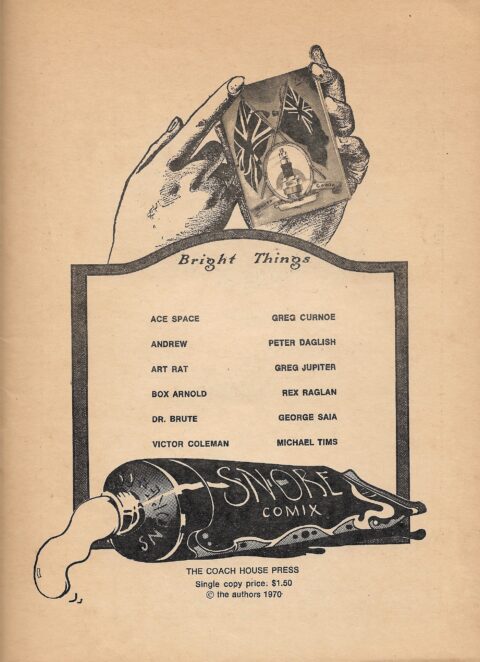
4. [MR PEANUT FLIPBOOK]. [48 leaves]: Printed recto in blue ink and side-stapled thrice in self-covers. 74 x 64 x 5 mm. No text, colophon, title, or imprint. Produced in a very small edition during Vincent Trasov’s visit to Toronto (and Toronto Island, as depicted later on the historic cover of the first issue of FILE Megazine, April 72).
Analysis: Here, Dan’s source does not offer us much new information about the “Mr. Peanut Flipbook,” but does situate its creation during Trasov’s visit to Toronto while on his North American tour dressed as Mr. Peanut. The fact that the image used on the cover of the first issue of File Megazine (which I shared last month) was taken during the same trip is an important connection to General Idea. This, combined with the listing for the flipbook in the catalogue pictured above proves beyond a doubt that this was part of the Snore Comix line.
5. SHOE JOURNAL Illustrations and text supplied by George Saia [Slobodan Saia-Levy aka Jorge Zontal] / A General idea Production. 1971. [64pp]: Unopened & unbound (self covers). 154 x 117 x 3 mm. Never formally issued, though copies of the folded sheets hung around the press for ages.
Analysis: As we now know, the Shoe Journal was formally released by Art Metropole in a hardbound limited edition in 2007 (see above). This would be the final connection between Snore Comix and General Idea, as the members of the group would turn their attention to File Megazine.
6. [THE SLUG BOOK by Gerry Gilbert] FOG PRONDL POP [cover text, a take-off from Basho]. [24 leaves]: Newsprint; side-stapled twice in self-covers. 102 x 132 x 3 mm landscape production. Multi-colour holograph & rubber-stamp booklet produced by the artist for Victor Coleman’s Wednesday Poetry Class, in an edition of only 7 numbered multiples (including a separate cover leaf numbered “0/7”).
Analysis: After the Shoe Journal failed to be published, the Snore Comix line was essentially finished. The fact that the sixth issue of the series was limited to only seven copies made in-house as part of a poetry class is telling. It is unclear why this happened, as it was obviously intended for publication based on it being included in the abovementioned Coach House catalogue. Fortunately, Dan’s source provided us with several images of “The Slug Book,” which have likely never been shared online before now.
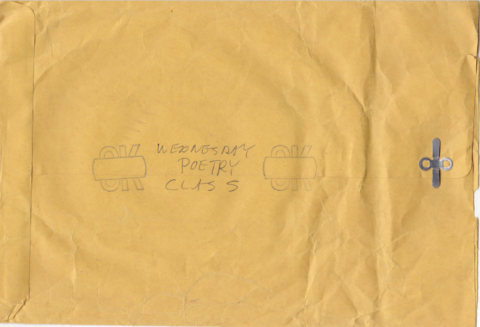
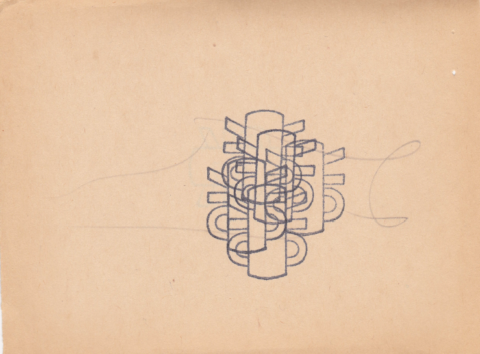
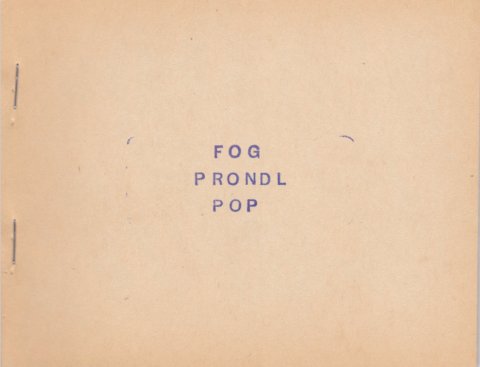
7. THE COACH HOUSE NOSE WHO’S WHO by Eduard Lang [ie, Jim Lang]. No info on hand because if I remember correctly only a mock-up got made. The mock-up was sold many years ago to the National Library.
Analysis: Mystery solved: Snore Comix # 7 was only ever created as a mock-up and was never formally released. This is an unfortunate end to this particular mystery. Perhaps someday a researcher will uncover this in the bowels of the National Library. Unfortunately, Dan’s source did not have images to share.
7.1 EVERYTHING by Everything Associates [ie, Robert Amos]. [64pp]: Stitched twice in illustrated card covers. 145 x 108 x 4 mm. Undated, but I think 1973. [500 copies?]
Analysis: Learning about Snore Comix # 7.1 (as Dan’s source calls it) was a surprise. Amos was born in Belleville, Ontario and attended York University in Toronto during the early 1970s. After publishing “Everything” and another publication with Coach House called Baron + Rago’s in 1973, he moved to British Columbia and became Assistant to the Director of the Art Gallery of Greater Victoria. He is still active today as one of Victoria’s better-known artists and writers and has published three books about painter E.J. Hughes since 2018.
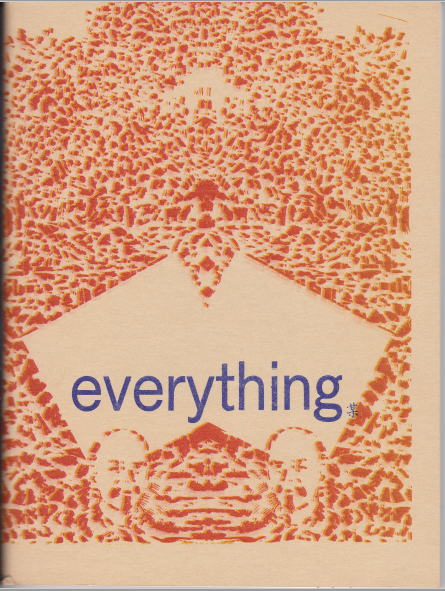
8. IRATA [by Arthur Cravan, the pseudonym of Nick Drumbolis]. [4pp]. 140 x 108 mm leaflet. Produced on May 17, 1994 at Coach House Press (photocopy) & LETTERS (rubberstamp) in an edition of 50 mechanically-numbered copies, as an errata slip for twobitter 49: back / lane / letters by bpNichol (which was handed out during the induction of bpNichol Lane). The correction involves the terminal poem, bpNichol’s Basho variations (prompting the association with Snore Comix # 6 by Gerry). 26 copies were included in Gronkbag L edited by jwcurry and Arthur Cravan (on September 30, 1994), while another 14 were included in the 14 boxed sets of twobitter.
Analysis: The final issue of Snore Comix, “Irata,” is an interesting bookend for the series insofar as it was released over twenty years after the final issue of the original series was published. It pays homage to early Snore Comix contributor (and Canadian legend) bpNichol as part of the celebrations renaming the street where Coach House Press is located in Toronto. It’s a fun “easter egg” that also pays homage to Coach House itself and is a neat send-off for the Canadian Silver Age’s strangest comic book series that is not really a comic book series at all.
The history of Snore Comix is as complicated and mysterious as it is to try to decipher the concrete poetry, experimental, avant-garde, and esoteric contents of these works. We now know that the series was initiated by Ohio printer Jerry Emerick and some of his fellow draft dodgers. By the second issue, however, a who’s who of Canada’s up and coming avant-garde artists was involved in the publication. By the third issue, “Bright Things,” the series had become an early vehicle for General Idea, the mail art movement and, to a lesser extent, members of Vancouver’s Western Front. After Vincent Trasov’s “Mr. Peanut Flipbook” was released, the series sputtered out and disappeared, with later issues not really ever coming to fruition other than Robert Amos’ “Everything,” and the final send-off, “IRATA,” in 1994.
Comic collectors will be quick to point out that none of these issues (with perhaps the exception of “Bright Things”) are really comic books at all. Snore Comix is really only worth discussing as a series of comics because the creators decided to refer to them as such, which can lead to all sorts of analyses.
Ultimately, it is up to each individual collector to determine whether or not this series is a fit for you. For enthusiasts of Canadian art and poetry, these should be on your radar. Despite its scarcity, “Bright Things,” is also one of the few ways to acquire an original work by members of General Idea that is affordable. Thanks to Dan’s confidential source, we have now put the history of Snore Comix to rest, though admittedly there are many contributors that we have still not identified. Perhaps we never will. Maybe I will return to the topic someday. Ultimately, the Coach House may know who’s who, but we are still working on it.


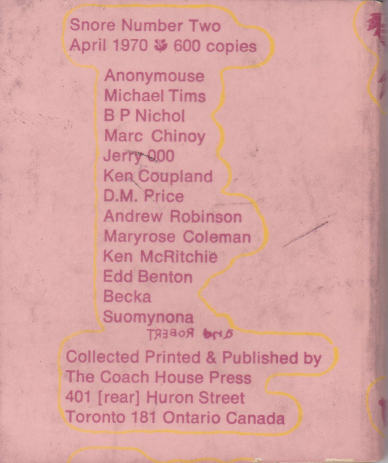
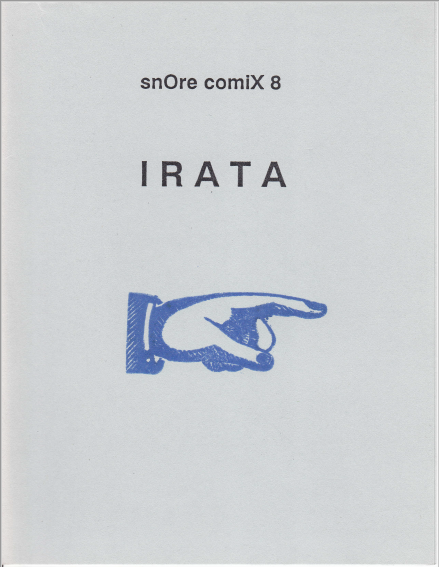
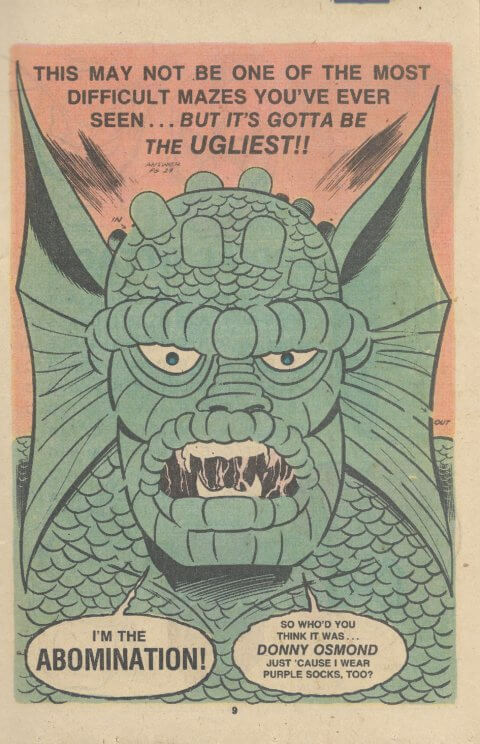
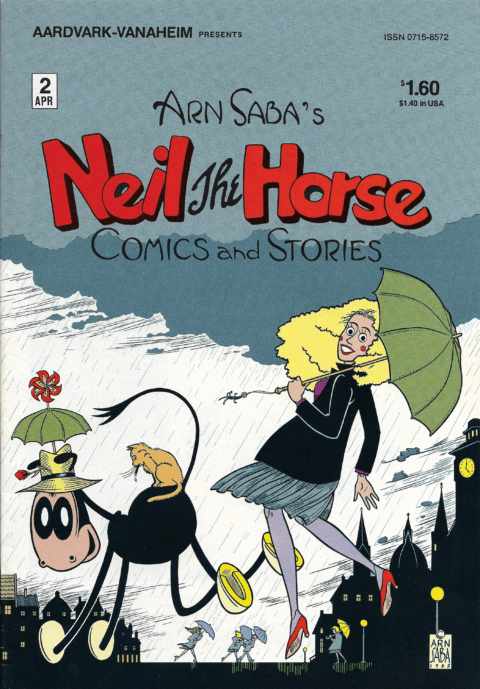
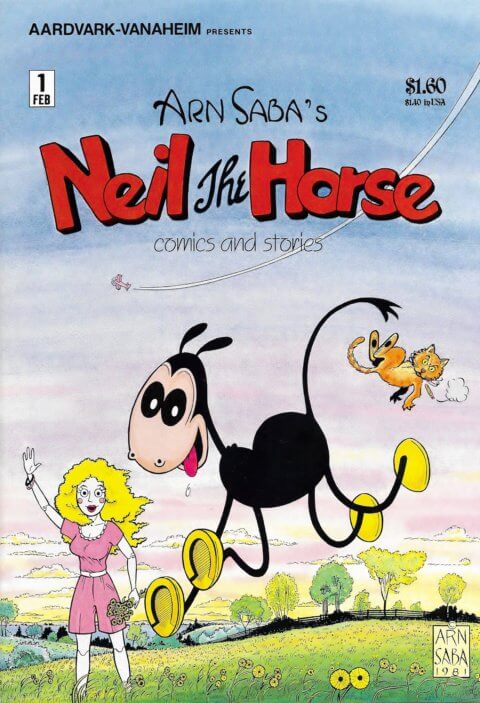
Well-researched and informative piece that taps some remote sources. We eventually have to think about getting our research here out in some form of a print copy.
Thanks for your comment, Ivan. Much appreciated. I agree that we will have to look at getting our Comic Book Daily research out there in print form at some point. It is certainly a long term goal of mine!
Mary Canary was Toronto Islander, Mary Creaghan McConnell (1947-99). Everything Associates was both Catherine McTavish & Robert Amos. Numerous copies of the unbound Shoe Journal were in fact distributed at CHP (which is why AA had only 120 of the original 200 copies remaining from which to commission Robert’s bound issue). art
Thanks for chiming in, art, and for confirming the identity of Mary Canary and adding Catherine McTavish to the list too. Regarding Shoe Journal, are you saying that original copies were in fact distributed? If you have additional information, please don’t hesitate to contact me directly.
Thanks again, brian
Cdnt find yr email Bry. “Distributed” has a different connotation today than back then. When you dropped in to Coach House in the early 70s, you were likely to get hedfed & have all manner of recent ephemera & unmentionables mirthfully laid on you by the mischievous elves who conjured it all up. Occasionally you’d find nuggets that had fallen moons before between the slats in the skids on the dirt floor of the “warehouse” (an archive of historic proportions). Shoe Jrnl was stacked there on a rickety shelf in the cold (alongside #2, Hsin Hsin Ming & endless postcards) free for the taking. I had numerous copies in my shop, which in the approved fashion, were all given away free (along with everything produced at Letters). I have one copy left (in the Snore Comix archive). You hafta remember it was a barter reality backwhen. One client paid for services with a vial of liquid acid, proffering the wages of eternal litry sin… Puts a new meaning on liquid finance (or for that matter, being liquidated..). The idea was that art was an idea & once it turned concrete you’d turn to a new idea (leaving the puzzler for passersby to ponder). Kinda like a breadcrumb trail thru the trees. n
art, my apologies for missing this comment. Thanks for your insights. You can reach me at [email protected] or through Facebook at https://www.facebook.com/EastCoastToysandGames/